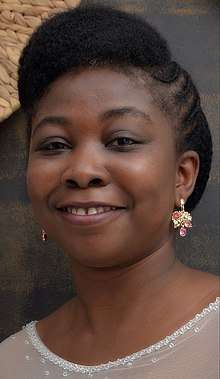Marian Asantewah Nkansah
Marian Asantewah Nkansah is a Ghanaian environmental chemist. In 2016, together with some scientists from the Kwame Nkrumah University of Science and Technology, she led a research which led to the confirmation that edible white clay poses potential cancer risk.[1][2] In 2016, she became the first scientist to win the Fayzah M. Al-Kharafi Prize, an annual award that recognises exceptional women scientists from scientifically and technologically lagging countries.[3] She and Collins Obuah, another scientist from the University of Ghana, were the two scientist selected to attend the Lindau Nobel Laureate meeting in 2017.[4]
Professor Marian Asantewah Nkansah | |
|---|---|
 | |
| Born | Marian Asantewah Nkansah |
| Nationality | Ghanaian |
| Education | Kwame Nkrumah University of Science and Technology University of Bergen |
| Scientific career | |
| Fields | Chemistry |
| Institutions | Kwame Nkrumah University of Science and Technology |
Education
Nkansah was born in Ghana to Mary and Joseph Nkansah, both educationists. She had her primary and secondary school education at St. Anthony's Experimental School, Nkawkaw and the St. Roses Senior High School at Akwatia, respectively and all in the Eastern Region of Ghana. She then furthered at the Kwame Nkrumah University of Science and Technology where she acquired a bachelor's degree in Chemistry and a master's degree in Environmental Chemistry. She holds a PhD in Environmental Chemistry from the University of Bergen in Norway.[5][6][7]
Career
She is currently a senior lecturer in the Chemistry department of Kwame Nkrumah University of Science and Technology where she teaches Practical Chemistry, Nuclear/Radiochemistry, Chemistry and Society, and Petroleum Chemistry. She is a member of the Global Young Academy.[6][8][9]
Works
Her research work focuses on finding solutions to environmental problems associated with levels and fate of toxic substances such as heavy/trace metals, persistent organic pollutants (POPs) and polycyclic aromatic hydrocarbons (PAHs) in food, water, soil, rocks, sediments and other environmental samples.[9] She also researches on the interaction of these pollutants with each other in the environment. Her publications include:
- 2010 - "Assessment of the quality of water from hand-dug wells in Ghana", published in Environmental Health Insights
- 2012 - "The use of lightweight expanded clay aggregate (LECA) as sorbent for PAHs removal from water", published in Journal of Hazardous Materials.
Awards and recognition
Nkansah has been recognised and awarded for her work including:[10][5][6][7]
- She is an affiliate of the African Academy of Sciences
- Featured in the first-ever book on African Women in Science
- Next Einstein Forum Fellow
- 2016 - Winner of the Fayzah M. Al-Kharafi Prize
- 2017 - Selected to attend Lindau Nobel Laureate meeting
- 2017 - Selection to the Global Young Academy
References
- "White clay poses cancer risk - Researchers". www.myjoyonline.com. Retrieved 2019-10-15.
- "White clay poses cancer risk - Researchers | Health News 2019-03-12". www.ghanaweb.com. Retrieved 2019-10-15.
- "Ghanaian researcher wins first Al-Kharafi Prize | General News 2016-11-16". www.ghanaweb.com. Retrieved 2019-10-15.
- "Two Ghanaian scientists selected for prestigious Nobel Laureates meeting". www.pulse.com.gh. 2017-06-20. Retrieved 2019-10-15.
- "Nkansah, Marian Asantewah". TWAS. Retrieved 2019-10-15.
- "NEF Fellow - Marian Asantewah Nkansah". Next Einstein Forum. Retrieved 2019-10-15.
- "Marian Asantewah Nkansah". IUPAC 100. Retrieved 2019-10-16.
- "Marian Asantewah Nkansah". www.sheathe.org. Retrieved 2019-10-15.
- "Marian Asantewah Nkansah's Profile |". Global Young Academy. Retrieved 2019-10-15.
- "Nkansah Marian Asantewah | The AAS". www.aasciences.africa. Retrieved 2019-10-15.